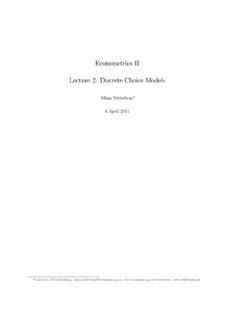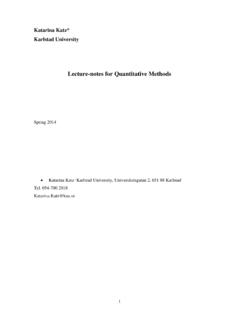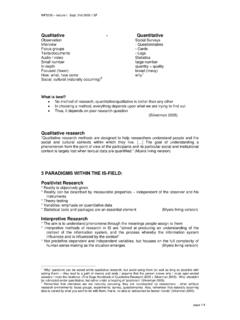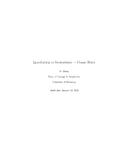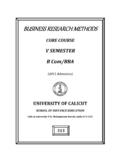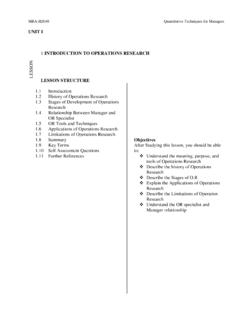Transcription of Applied Econometrics Lecture 10: Binary Choice Models
1 Applied EconometricsLecture 10: Binary Choice ModelsM ns S derbom 22 September 2009 University of Gothenburg. IntroductionThe methods discussed thus far in the course are well suited for modelling a acontinuous,quantitativevariable - economic growth, the log of value-added or output, the log of earnings economic phenomena of interest, however, concern variables that are not continuous or perhapsnot even quantitative . What characteristics ( parental) a ect the likelihood that an individual obtains a higher degree? What determines labour force participation (employed vs not employed)? What factors drive the incidence of civil war?Today we will discussbinary Choice Models . These are central Models in Applied Binary Choice Models are useful when our outcome variable of interest is Binary - a commonsituation in Applied work.
2 Moreover, the Binary Choice model is often used as aningredientin othermodels. For example: In propensity score matching Models (to be covered in lectures 11-12), we identify the averagetreatment e ect by comparing outcomes of treated and non-treated indivduals who, a priori, havesimilar probabilities of being treated. The probability of being treated is typically modelled usingprobit. In Heckman s selection model, we use probit in the rst stage to predict the likelihood that someoneis included (selected) in the sample. We then control for the likelihood of being selected whenestimating our equation of interest ( a wage equation)The Binary Choice model is also a good starting point if we want to study more complicated on in the course we will thus coverextensionsof the Binary Choice model, such as Models formultinomial or ordered response, and Models combining continuous and discrete outcomes ( cornerresponse Models ).
3 These extensions will be discussed in lectures 13-14. Finally, in Lecture 15 we will see2how these Models can be modi ed to take into account unobserved heterogeneity, whenpanel references for this Lecture :Wooldrigde, J. (2002)Econometric Analysis of Cross Section and Panel (readcarefully).Angrist, Joshua and J rn-Stefen Pischke (2009). Mostly Harmless Econometrics . An Empiricist sCompanion. Chapter (skim).Kingdon, G. (1996) The quality and e ciency of private and public education: a case-study of urbanIndia, Oxford Bulletin of Economics and Statistics58: 57-81 (most of the empirical examples below willdraw on this paper).In addition, I will draw on material presented in the following three papers:Martins, M. F. O. 2001. Parametric and semiparametric estimation of sample selection Models : anempirical application to the female labour force in Portugal, Journal of Applied Econometrics16, , Adrian.
4 2002. "Learning about Models and their Fit to Data,"International EconomicJournal16:2, , Adrian and Frank Vella. 1989. Diagnostic Tests for Models Based on Individual Data: ASurvey, Journal of Applied Econometrics4: papers are not required Binary Response ModelsWhenever the variable that we want to model is Binary , it is natural to think in terms ofprobabilities, What is the probability that an individual with such and such characteristics owns a car? If some variable X changes by one unit, what is the e ect on the probability of owning a car? When the dependent variableyis Binary , it is typically equal to one for all observations in the data forwhich the event of interest has happened ( success ) and zero for the remaining observations ( failure ).Provided we have a random sample, the sample mean of this Binary variable is an unbiased estimateof the unconditional probability that the event happens.
5 That is, lettingydenote our Binary dependentvariable, we havePr (y= 1) =E(y) =PiyiN;whereNis the number of observations in the the unconditional probability is trivial, but usually not the most interesting thing we cando with the data. Suppose we want to analyse what factors determine changes in the probability thatyequals one. Can we use the classical linear regression framework to this end?3. Estimation by OLS: The Linear Probability ModelConsider the linear regression modely= 1+ 2x2+:::+ KxK+u=x +u;( )where is aK 1vector of parameters,xis aN Kmatrix of explanatory variables, anduis a now, we will assume that the residual is uncorrelated with the regressors, that endogeneity is nota problem. This allows us to use OLS to estimate the parameters of To interpret the results, note that if we take expectations on both sides of the equation above weobtainE(yjx; ) =x : Now, just like the unconditional probability thatyequals one is equal to the unconditional expectedvalue ofy, (y) = Pr (y= 1), the conditional probability thatyequals one is equal to theconditional expected value ofy:Pr (y= 1jx) =E(yjx; );Pr (y= 1jx) =x :( )Because probabilities must sum to one, it must also be thatPr (y= 0jx) = 1 x : Equation ( ) is abinary response model.
6 In this particular model the probability of success( 1)is alinearfunction of the explanatory variables in the vectorx. This is why usingOLS with a Binary dependent variable is called thelinear probability model(LPM).Notice that in the LPM the parameter jmeasures the change in the probability of success , resultingfrom a change in the variablexj, holding other factors xed: Pr (y= 1jx) = j xj:This can be interpreted as a partial e ect on the probability of success .EXAMPLE: Modelling the probability of going to a private, unaided school (PUA) in , Table data for this example are taken from the study by Kingdon (1996).5 Summary statistics LPM. Shortcomings of the Linear Probability ModelClearly the LPM is straightforward to estimate, however there are some important shortcomings. One undesirable property of the LPM is that, if we plug in certain combinations of values for theindependent variables into ( ), we can get predictions either less than zero or greater than course a probability by de nition falls within the (0,1) interval, so predictions outside this rangeare meaningless and somewhat embarrassing.
7 This is not an unusual result; for instance, based onthe above LPM results, there are 61 observations for which the predicted probability is larger thanone and 81 observations for which the predicted probability is less than zero. That is, 16 per centof the predictions fall outside the (0,1) interval in this application (see Figure 1 in the appendix,and the summary statistics for the predictions reported below the table). Angrist and Pischke ( ): "..[linear regression] may generate tted values outside the LDVboundaries. This fact bothers some researchers and has generated a lot of bad press for the linearprobability model." A related problem is that, conceptually, it does not make sense to say that a probability islinearlyrelated to a continuous independent variable for all possible values. If it were, then continuallyincreasing this explanatory variable would eventually driveP(y= 1jx)above one or below example, the model above predicts that an increase in parental wealth by 1 unit increases theprobability of going to a PUA school by about 1 percentage point.
8 This may seem reasonable forfamilies with average levels of wealth, however in very rich or very poor families the wealth e ectis probably smaller. In fact, when taken to the extreme our model implies that a hundred-foldincrease in wealth increases the probability of going to a PUA by more than 1 which, of course, isimpossible (the wealth variable ranges from to 82 in the data, so such an comparison is not6unrealistic). A third problem with the LPM - arguably less serious than those above - is that the residual isheteroskedastic by de nition. Why is this? Becauseytakes the value of 1 or 0, the residuals inequation ( ) can take only two values, conditional onx:1 xand x. Further, the respectiveprobabilities of these events are xand1 x. Hence,var(ujx) = Pr (y= 1jx) [1 x ]2+ Pr (y= 0jx) [ x ]2=x [1 x ]2+ (1 x ) [ x ]2=x [1 x ];which clearly varies with the explanatory variablesx.
9 The OLS estimator is still unbiased, but theconventional formula for estimating the standard errors, and hence the t-values, will be wrong. Theeasiest way of solving this problem is to obtain estimates of the standard errors that are robust toheteroskedasticity. EXAMPLE continued: Appendix - LPM with robust standard errors, Table 1b; compare to LPMwith non-robust standard errors (Table 1a). A fourth and related problem is that, because the residual can only take two values, it cannot benormally distributed. The problem of non-normality means that OLS point estimates are unbiasedbut its violation does mean that inference in small samples cannot be based on the usual suite ofnormality-based distributions such as : The LPM can be useful as a rst step in the analysis of Binary choices, but awkward issues arise ifwe want to argue that we are modelling a As we shall see next, probit and logit solve these particular problems.
10 Nowadays, these are just aseasy to implement as LPM/OLS - but they are less straightforward to interpret. However, LPM remains a reasonably popular modelling framework (see Miguel, Satyanath andSergenti, JPE, 2004), because certain econometric problems are easier to address within the LPMframework than with probits and logits. If, for whatever reason, we use the LPM, it is important to recognise that it tends to give betterestimates of the partial e ects on the response probability near the centre of the distribution ofx than at extreme values ( close to 0 and 1). The LPM graph in the appendix illustrates this(Figure 1).4. Logit and Probit Models for Binary ResponseThe two main problems with the LPM were: nonsense predictions are possible (there is nothing to bindthe value of Y to the (0,1) range); and linearity doesn t make much sense address these problems we abandon the LPM and thus the OLS approach to estimating binaryresponse Models .


